The electrical resistance of an object is a measure of its opposition to the flow of electric current. The inverse quantity is electrical conductance, and is the ease with which an electric current passes. Electrical resistance shares some conceptual parallels with the notion of mechanical friction. The SI unit of electrical resistance is the ohm (Ω), while electrical conductance is measured in siemens (S).
The resistance of an object depends in large part on the material it is made of—objects made of electrical insulators like rubber tend to have very high resistance and low conductivity, while objects made of electrical conductors like metals tend to have very low resistance and high conductivity. This material dependence is quantified by resistivity or conductivity. However, resistance and conductance are extensive rather than bulk properties,
meaning that they also depend on the size and shape of an object. For
example, a wire's resistance is higher if it is long and thin, and lower
if it is short and thick. All objects show some resistance, except for superconductors, which have a resistance of zero.
The resistance (R) of an object is defined as the ratio of voltage across it (V) to current through it (I), while the conductance (G) is the inverse:
In other cases, such as a transformer, diode or battery, V and I are not directly proportional. The ratio V/I is sometimes still useful, and is referred to as a "chordal resistance" or "static resistance", since it corresponds to the inverse slope of a chord between the origin and an I–V curve. In other situations, the derivative may be most useful; this is called the "differential resistance".
The resistance (R) of an object is defined as the ratio of voltage across it (V) to current through it (I), while the conductance (G) is the inverse:
In other cases, such as a transformer, diode or battery, V and I are not directly proportional. The ratio V/I is sometimes still useful, and is referred to as a "chordal resistance" or "static resistance", since it corresponds to the inverse slope of a chord between the origin and an I–V curve. In other situations, the derivative may be most useful; this is called the "differential resistance".
Introduction
The hydraulic analogy
compares electric current flowing through circuits to water flowing
through pipes. When a pipe (left) is filled with hair (right), it takes a
larger pressure to achieve the same flow of water. Pushing electric
current through a large resistance is like pushing water through a pipe
clogged with hair: It requires a larger push (electromotive force) to drive the same flow (electric current).
In the hydraulic analogy, current flowing through a wire (or resistor) is like water flowing through a pipe, and the voltage drop across the wire is like the pressure drop that pushes water through the pipe. Conductance is proportional to how much flow occurs for a given pressure, and resistance is proportional to how much pressure is required to achieve a given flow. (Conductance and resistance are reciprocals.)
The voltage drop (i.e., difference between voltages on one side of the resistor and the other), not the voltage itself, provides the driving force pushing current through a resistor. In hydraulics, it is similar: The pressure difference between two sides of a pipe, not the pressure itself, determines the flow through it. For example, there may be a large water pressure above the pipe, which tries to push water down through the pipe. But there may be an equally large water pressure below the pipe, which tries to push water back up through the pipe. If these pressures are equal, no water flows. (In the image at right, the water pressure below the pipe is zero.)
The resistance and conductance of a wire, resistor, or other element is mostly determined by two properties:
- geometry (shape), and
- material
Materials are important as well. A pipe filled with hair restricts the flow of water more than a clean pipe of the same shape and size. Similarly, electrons can flow freely and easily through a copper wire, but cannot flow as easily through a steel wire of the same shape and size, and they essentially cannot flow at all through an insulator like rubber, regardless of its shape. The difference between copper, steel, and rubber is related to their microscopic structure and electron configuration, and is quantified by a property called resistivity.
In addition to geometry and material, there are various other factors that influence resistance and conductance, such as temperature; see below.
Conductors and resistors
A 6.5 MΩ resistor, as identified by its electronic color code (blue–green–black-yellow-red). An ohmmeter could be used to verify this value.
Substances in which electricity can flow are called conductors. A piece of conducting material of a particular resistance meant for use in a circuit is called a resistor. Conductors are made of high-conductivity materials such as metals, in particular copper and aluminium. Resistors, on the other hand, are made of a wide variety of materials depending on factors such as the desired resistance, amount of energy that it needs to dissipate, precision, and costs.
Ohm's law
The current-voltage characteristics of four devices: Two
voltage drop, the vertical axis is current. Ohm's law is satisfied
when the graph is a straight line through the origin. Therefore,
the two resistors are ohmic, but the diode and battery are not.
For many materials, the current I through the material is proportional to the voltage V applied across it:
Other components and materials used in electronics do not obey Ohm's law; the current is not proportional to the voltage, so the resistance varies with the voltage and current through them. These are called nonlinear or nonohmic. Examples include diodes and fluorescent lamps. The IV curve of a nonohmic device is a curved line.
Relation to resistivity and conductivity
A piece of resistive material with electrical contacts on both ends.
The resistance of a given object depends primarily on two factors: What material it is made of, and its shape. For a given material, the resistance is inversely proportional to the cross-sectional area; for example, a thick copper wire has lower resistance than an otherwise-identical thin copper wire. Also, for a given material, the resistance is proportional to the length; for example, a long copper wire has higher resistance than an otherwise-identical short copper wire. The resistance R and conductance G of a conductor of uniform cross section, therefore, can be computed as
This formula is not exact, as it assumes the current density is totally uniform in the conductor, which is not always true in practical situations. However, this formula still provides a good approximation for long thin conductors such as wires.
Another situation for which this formula is not exact is with alternating current (AC), because the skin effect inhibits current flow near the center of the conductor. For this reason, the geometrical cross-section is different from the effective cross-section in which current actually flows, so resistance is higher than expected. Similarly, if two conductors near each other carry AC current, their resistances increase due to the proximity effect. At commercial power frequency, these effects are significant for large conductors carrying large currents, such as busbars in an electrical substation, or large power cables carrying more than a few hundred amperes.
What determines resistivity?
The resistivity of different materials varies by an enormous amount: For example, the conductivity of teflon is about 1030 times lower than the conductivity of copper. Why is there such a difference? Loosely speaking, a metal has large numbers of "delocalized" electrons that are not stuck in any one place, but free to move across large distances, whereas in an insulator (like teflon), each electron is tightly bound to a single molecule, and a great force is required to pull it away. Semiconductors lie between these two extremes. More details can be found in the article: Electrical resistivity and conductivity. For the case of electrolyte solutions, see the article: Conductivity (electrolytic).Resistivity varies with temperature. In semiconductors, resistivity also changes when exposed to light. See below.
Measuring resistance
An instrument for measuring resistance is called an ohmmeter. Simple ohmmeters cannot measure low resistances accurately because the resistance of their measuring leads causes a voltage drop that interferes with the measurement, so more accurate devices use four-terminal sensing.Typical resistances
| Component | Resistance (Ω) |
|---|---|
| 1 meter of copper wire with 1 mm diameter | 0.02 |
| 1 km overhead power line (typical) | 0.03 |
| AA battery (typical internal resistance) | 0.1 |
| Incandescent light bulb filament (typical) | 200–1000 |
| Human body | 1000 to 100,000 |
Static and differential resistance
The IV curve of a non-ohmic device (purple). The static resistance at point A is the inverse slope of line B through the origin. The differential resistance at A is the inverse slope of tangent line C.
The IV curve of a component with negative differential resistance, an unusual phenomenon where the IV curve is non-monotonic.
Many electrical elements, such as diodes and batteries do not satisfy Ohm's law. These are called non-ohmic or non-linear, and their I–V curves are not straight lines through the origin.
Resistance and conductance can still be defined for non-ohmic elements. However, unlike ohmic resistance, non-linear resistance is not constant but varies with the voltage or current through the device; i.e., its operating point. There are two types of resistance
- Static resistance (also called chordal or DC resistance) – This corresponds to the usual definition of resistance; the voltage divided by the current
- .
- It is the slope of the line (chord) from the origin through the point on the curve. Static resistance determines the power dissipation in an electrical component. Points on the IV curve located in the 2nd or 4th quadrants, for which the slope of the chordal line is negative, have negative static resistance. Passive devices, which have no source of energy, cannot have negative static resistance. However active devices such as transistors or op-amps can synthesize negative static resistance with feedback, and it is used in some circuits such as gyrators.
- Differential resistance (also called dynamic, incremental or small signal resistance) – Differential resistance is the derivative of the voltage with respect to the current; the slope of the IV curve at a point
- .
- If the IV curve is nonmonotonic (with peaks and troughs), the curve has a negative slope in some regions—so in these regions the device has negative differential resistance. Devices with negative differential resistance can amplify a signal applied to them, and are used to make amplifiers and oscillators. These include tunnel diodes, Gunn diodes, IMPATT diodes, magnetron tubes, and unijunction transistors.
AC circuits
Impedance and admittance
The voltage (red) and current (blue) versus time (horizontal axis) for a capacitor (top) and inductor (bottom). Since the amplitude of the current and voltage sinusoids are the same, the absolute value of impedance is 1 for both the capacitor and the inductor (in whatever units the graph is using). On the other hand, the phase difference between current and voltage is −90° for the capacitor; therefore, the complex phase of the impedance of the capacitor is −90°. Similarly, the phase difference between current and voltage is +90° for the inductor; therefore, the complex phase of the impedance of the inductor is +90°.
When an alternating current flows through a circuit, the relation between current and voltage across a circuit element is characterized not only by the ratio of their magnitudes, but also the difference in their phases. For example, in an ideal resistor, the moment when the voltage reaches its maximum, the current also reaches its maximum (current and voltage are oscillating in phase). But for a capacitor or inductor, the maximum current flow occurs as the voltage passes through zero and vice versa (current and voltage are oscillating 90° out of phase, see image at right). Complex numbers are used to keep track of both the phase and magnitude of current and voltage:
- t is time,
- V(t) and I(t) are, respectively, voltage and current as a function of time,
- V0, I0, Z, and Y are complex numbers,
- Z is called impedance,
- Y is called admittance,
- Re indicates real part,
- is the angular frequency of the AC current,
- is the imaginary unit.
for AC circuits, just as for DC circuits.
Frequency dependence of resistance
Another complication of AC circuits is that the resistance and conductance can be frequency-dependent. One reason, mentioned above is the skin effect (and the related proximity effect). Another reason is that the resistivity itself may depend on frequency (see Drude model, deep-level traps, resonant frequency, Kramers–Kronig relations, etc.)Energy dissipation and Joule heating
Running current through a material with high resistance creates heat, in a phenomenon called Joule heating. In this picture, a cartridge heater, warmed by Joule heating, is glowing red hot.
Resistors (and other elements with resistance) oppose the flow of electric current; therefore, electrical energy is required to push current through the resistance. This electrical energy is dissipated, heating the resistor in the process. This is called Joule heating (after James Prescott Joule), also called ohmic heating or resistive heating.
The dissipation of electrical energy is often undesired, particularly in the case of transmission losses in power lines. High voltage transmission helps reduce the losses by reducing the current for a given power.
On the other hand, Joule heating is sometimes useful, for example in electric stoves and other electric heaters (also called resistive heaters). As another example, incandescent lamps rely on Joule heating: the filament is heated to such a high temperature that it glows "white hot" with thermal radiation (also called incandescence).
The formula for Joule heating is:
Dependence of resistance on other conditions
Temperature dependence
Near room temperature, the resistivity of metals typically increases as temperature is increased, while the resistivity of semiconductors typically decreases as temperature is increased. The resistivity of insulators and electrolytes may increase or decrease depending on the system. For the detailed As a consequence, the resistance of wires, resistors, and other components often change with temperature. This effect may be undesired, causing an electronic circuit to malfunction at extreme temperatures. In some cases, however, the effect is put to good use. When temperature-dependent resistance of a component is used purposefully, the component is called a resistance thermometer or thermistor. (A resistance thermometer is made of metal, usually platinum, while a thermistor is made of ceramic or polymer.)Resistance thermometers and thermistors are generally used in two ways. First, they can be used as thermometers: By measuring the resistance, the temperature of the environment can be inferred. Second, they can be used in conjunction with Joule heating (also called self-heating): If a large current is running through the resistor, the resistor's temperature rises and therefore its resistance changes. Therefore, these components can be used in a circuit-protection role similar to fuses, or for feedback in circuits, or for many other purposes. In general, self-heating can turn a resistor into a nonlinear and hysteretic circuit element.
If the temperature T does not vary too much, a linear approximation is typically used:
The temperature coefficient is typically +3×10−3 K−1 to +6×10−3 K−1 for metals near room temperature. It is usually negative for semiconductors and insulators, with highly variable magnitude.





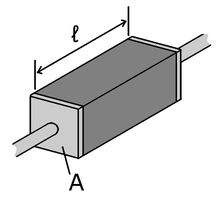



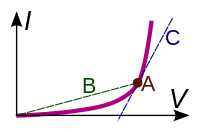
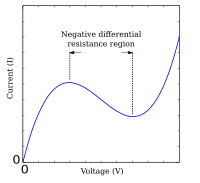


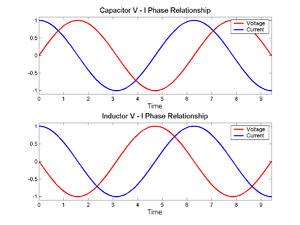





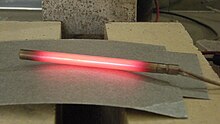

![R(T) = R_0[1+\alpha (T - T_0)]](https://wikimedia.org/api/rest_v1/media/math/render/svg/5b6622ab35566bd32d26736effa752dc8ace798d)




